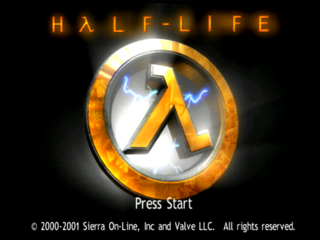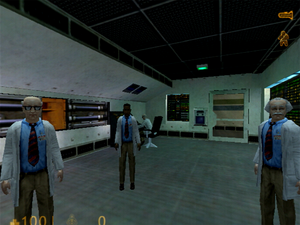Difference between revisions of "Half-Life"
From Sega Retro
| Line 64: | Line 64: | ||
}} | }} | ||
<gallery> | <gallery> | ||
| − | CVG UK 219.pdf|page=64|Preview in ''C&VG'' #219 | + | CVG UK 219.pdf|page=64|Preview in ''C&VG'' #219 (2000-02) |
| − | CVG UK 224.pdf|page=28|Preview in ''C&VG'' #224 | + | CVG UK 224.pdf|page=28|Preview in ''C&VG'' #224 (2000-07) |
| − | CVG UK 228.pdf|page=82|Review in ''C&VG'' #228 | + | CVG UK 228.pdf|page=82|Review in ''C&VG'' #228 (2000-11) |
| − | DCUK 16.pdf|page=58|Review in ''[[DC-UK]]'' #16 | + | ODCM US 08.pdf|page=46|Preview in ''[[Official Dreamcast Magazine (US)]]'' #8 (2000-11) |
| + | DCUK 16.pdf|page=58|Review in ''[[DC-UK]]'' #16 (2000-12) | ||
</gallery> | </gallery> | ||
Revision as of 14:21, 18 January 2016
| Half-Life |
|---|
| System(s): Sega Dreamcast |
| Publisher: Sierra On-Line |
| Developer: Valve Corporation Gearbox Software |
| Planned release date(s): 2000-09, 2000-11 [1] |
| Genre: Shoot-'em-Up |
| Number of players: 1 |
| Status of prototype(s): Prototype dumped |
Half-Life is a first person shooter developed by Valve Corporation. At the time of its release on PCs it was seen as groundbreaking, and still ranks as one of the highest rated PC games of all time.
The game was due to be ported to the Sega Dreamcast by Gearbox Software in a move that was much anticpated by Sega fans. However, a last minute decision saw the game be cancelled, despite playable (and finished) builds being showcased at trade shows and in magazine publications. Half-Life was set to be one of the biggest Dreamcast games of the year 2000 holiday season, ancitipated for a release in North America and Europe during September 2000 (a date it missed - DC-UK later claimed it would arrive in Europe in November of that year, priced at the usual £39.99 in the UK).
Contents
History
Half-Life was demonstrated at the European Computer Trade Show in 2000, being praised by the press and featuring as a cover story in many gaming magazines of the era and even in a television advertisement. Rather than being a straight port of the game, the Dreamcast version featured higher polygon models than its PC counterpart (allegedly twice as many polygons overall) and would have included an exclusive side-story titled Half-Life: Blue Shift. The Dreamcast version would not make an official playable public appearance until the first annual Gearbox Community Day 2011 which featured the last completed build as part of their legacy showcase.
Cancellation
Half-Life was unexpectedly delayed to mid-2001, and within just weeks of release, Sierra On-Line, the game's publisher, pulled the plug on the Dreamcast version due to "changing market conditions". By this point it was the middle of June 2001, and like many publishers around tihs time, Sierra chose not to support the Dreamcast console further. By this point Blue Shift had been released as a PC expansion pack (alongside the "High Definition Pack", upgrading all the in-game models), and much of the re-worked assets were being used in an upcoming PlayStation 2 version of the game, which launched in November 2001.
Leaked Build
Inevitably the full version of the Dreamcast game was leaked onto the internet, showing a near-complete product. Though the game is fully playable, the frame rate is inconsistent, and load times are often fairly lengthy. Saving is also an issue - the further the player gets through the current level, the more VMU blocks are demanded for saving. Once a level is completed, the number decreases again. In addition, each chapter is split with a password system to save progress alternatively with a three word system.
Some of the features found in the Dreamcast versions of Half-Life and Blue Shift were never brought forward into later copies of the game, although this mainly just includes some new NPC models, slightly altered level layouts and in-game Dreamcast references. In early 2012 a mod for the PC version was released on Steam to address this.
VMU Features
Half-Life is able to save progress anywhere in the game, however the further along in a chapter, the larger the file can get. Alternatively the game allows progress to be saved via a password system.
| Name | File Name | Comment | File Size | Icon |
|---|---|---|---|---|
| Half Life | HALFLIFE.### | HALF_LIFE_GAME | 30-200 |
Promotional Material
- HalfLife DC US PrintAdvert.jpg
US print advert
- HalfLife DC FR PrintAdvert.jpg
FR print advert
Magazine articles
| Sega Retro Average | ||||||||||||||||||||||||||||||||||
|---|---|---|---|---|---|---|---|---|---|---|---|---|---|---|---|---|---|---|---|---|---|---|---|---|---|---|---|---|---|---|---|---|---|---|
|
| 93 | |
|---|---|
| Based on 6 reviews | |
Preview in Official Dreamcast Magazine (US) #8 (2000-11)
Review in DC-UK #16 (2000-12)
- ↑ 1.0 1.1 1.2 File:CVG UK 228.pdf, page 82 Cite error: Invalid
<ref>tag; name ":File:CVG UK 228.pdf_p82" defined multiple times with different content - ↑ 2.0 2.1 File:DCUK 16.pdf, page 58 Cite error: Invalid
<ref>tag; name ":File:DCUK 16.pdf_p58" defined multiple times with different content - ↑ Dreamcast Monthly, "November 2000" (UK; 2000-09-28), page 62
- ↑ Dreamcast Magazine, "No. 15" (UK; 2000-11-02), page 56
- ↑ GamePro, "June 2001" (US; 2001-0x-xx), page 109
- ↑ SuperGamePower, "Junho 2001" (BR; 2001-xx-xx), page 34


